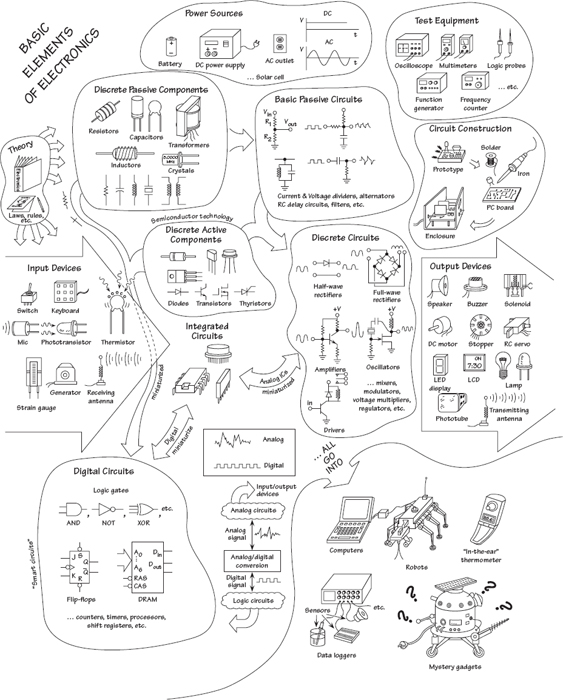Introduction to Electronics
Perhaps the most common predicament newcomers face when learning electronics is figuring out exactly what it is they must learn. What topics are worth covering, and in which general order should they be covered? A good starting point for answering these questions is the flowchart presented in Fig. 1.1. This chart provides an overview of the basic elements that go into designing practical electrical gadgets and represents the information you will find in this book. This chapter introduces these basic elements.
FIGURE 1.1
At the top of the chart comes the theory. This involves learning about voltage, current, resistance, capacitance, inductance, and various laws and theorems that help predict the size and direction of voltages and currents within circuits. As you learn the basic theory, you will be introduced to basic passive components such as resistors, capacitors, inductors, and transformers.
Next down the line are discrete passive circuits. Discrete passive circuits include current-limiting networks, voltage dividers, filter circuits, attenuators, and so on. These simple circuits, by themselves, are not very interesting, but they are vital ingredients in more complex circuits.
After you have learned about passive components and circuits, you move on to discrete active devices, which are built from semiconductor materials. These devices consist mainly of diodes (one-way current-flow gates) and transistors (electrically controlled switches/amplifiers).
Once you have covered the discrete active devices, you get to discrete active/passive circuits. Some of these circuits include rectifiers (ac-to-dc converters), amplifiers, oscillators, modulators, mixers, and voltage regulators. This is where things start getting interesting.
Throughout your study of electronics, you will learn about various input/output (I/O) devices (transducers). Input devices (sensors) convert physical signals, such as sound, light, and pressure, into electrical signals that circuits can use. These devices include microphones, phototransistors, switches, keyboards, thermistors, strain gauges, generators, and antennas. Output devices convert electrical signals into physical signals. Output devices include lamps, LED and LCD displays, speakers, buzzers, motors (dc, servo, and stepper), solenoids, and antennas. These I/O devices allow humans and circuits to communicate with one another.
To make things easier on the circuit designer, manufacturers have created integrated circuits (ICs), which contain discrete circuits (like the ones mentioned in the previous paragraph) that are crammed onto a tiny chip of silicon. The chip is usually housed within a plastic package, where little internal wires link the chip to external metal terminals. ICs such as amplifiers and voltage regulators are referred to as analog devices, which means that they respond to and produce signals of varying degrees of voltage. (This is unlike digital ICs, which work with only two voltage levels.) Becoming familiar with ICs is a necessity for any practical circuit designer.
Digital electronics comes next. Digital circuits work with only two voltage states: high (such as 5 V) or low (such as 0 V). The reason for having only two voltage states has to do with the ease of processing data (numbers, symbols, and control information) and storage. The process of encoding information into signals that digital circuits can use involves combining bits (1s and 0s, equivalent to high and low voltages) into discrete-meaning “words.” The designer dictates what these words will mean to a specific circuit. Unlike analog electronics, digital electronics uses a whole new set of components, which at the heart are all integrated in form.
A huge number of specialized ICs are used in digital electronics. Some of these ICs are designed to perform logical operations on input information; others are designed to count; while still others are designed to store information that can be retrieved later on. Digital ICs include logic gates, flip-flops, shift registers, counters, memories, processors, and so on. Digital circuits are what give electrical gadgets “brains.” In order for digital circuits to interact with analog circuits, special analog-to-digital (A/D) conversion circuits are needed to convert analog signals into strings of 1s and 0s. Likewise, digital-to-analog conversion circuits are used to convert strings of 1s and 0s into analog signals.
With an understanding of the principals behind digital electronics, we are free to explore the world of microcontrollers. These are programmable digital electronics that can read values from sensors and control output devices using the I/O pins, all on a single IC controlled by a little program.
And mixed in among all this is the practical side of electronics. This involves learning to read schematic diagrams, constructing circuit prototypes using breadboards, testing prototypes (using multimeters, oscilloscopes, and logic probes), revising prototypes (if needed), and constructing final circuits using various tools and special circuit boards.
In the next chapter, we will start at the beginning by looking at the theory of electronics.
..................Content has been hidden....................
You can't read the all page of ebook, please click here login for view all page.

